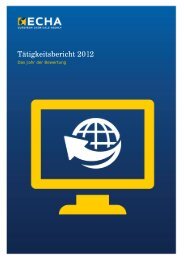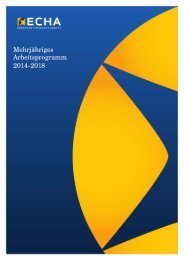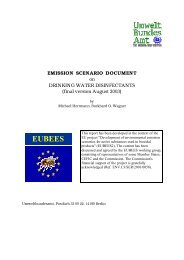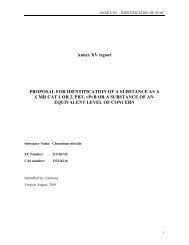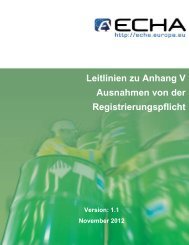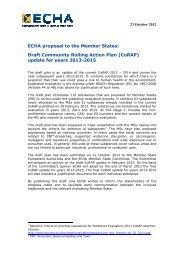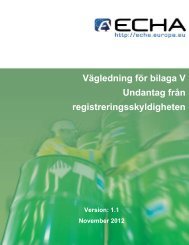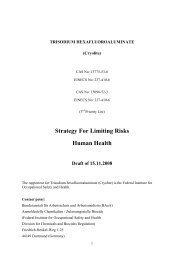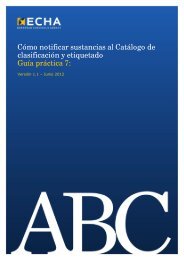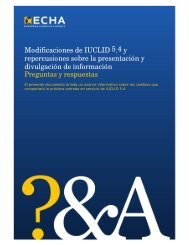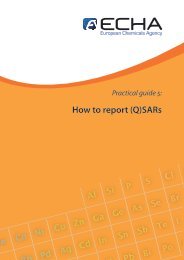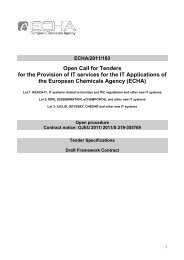Annex XV dossier PROPOSAL FOR ... - ECHA - Europa
Annex XV dossier PROPOSAL FOR ... - ECHA - Europa
Annex XV dossier PROPOSAL FOR ... - ECHA - Europa
You also want an ePaper? Increase the reach of your titles
YUMPU automatically turns print PDFs into web optimized ePapers that Google loves.
Summary of the IFA-Data<br />
ANNEX <strong>XV</strong> – IDENTIFICATION OF PMDA AS SVHC<br />
The data presented above reveal that airborne concentrations of MDA in the area of plastic<br />
and foam material processing and production are below the analytical limit of quantification<br />
(LOQ). Relevant airborne concentrations of MDA have only been observed in the branch<br />
group of steel foundry. The overall statistics for the steel foundry area (Table 8) estimates the<br />
95 th percentile to 0,0524 mg/m 3 (90 th percentile 0,0068 mg/m 3 ) in case of personal sampling.<br />
Although the number of personal samples are quite small (n = 16) the IFA data reveal that<br />
inhalation exposure to MDA may occur in the steel foundry area.<br />
IN<strong>FOR</strong>MATION ON ALTERNATIVES<br />
Alternative substances<br />
For alternatives for the uses that could be subject to authorisation (i.e. when MDA is<br />
considered not to be an intermediate), reference is made to [<strong>ECHA</strong>, 2008]. It is understood<br />
that other aromatic amines or aliphatic amines can be used as alternatives as curing agents in<br />
some circumstances although information on alternatives for specific applications has not<br />
been found.<br />
Based on the literature review undertaken in [<strong>ECHA</strong>, 2008], it has not been possible to gain a<br />
good overview of the current status of development of alternatives for the remaining non-MDI<br />
uses (particularly as hardener in epoxy resins and adhesives). Some promising alternatives<br />
have obviously been identified (as evidenced by a number of patents), though the actual<br />
market suitability of these alternatives is unknown.<br />
RISK-RELATED IN<strong>FOR</strong>MATION<br />
Risk related information for MDA is taken from the exposure-risk-relationship (ERB),<br />
published by the German Committee on Hazardous Substances (AGS) (AGS, 2010). The<br />
information from the ERB is reduced in this <strong>Annex</strong> <strong>XV</strong> document to the most critical<br />
endpoint, the carcinogenicity after inhalation and dermal contact. In the table below, all<br />
exposure scenarios are listed and compared with the calculated acceptance risk (4:10000). The<br />
quotient of exposure and acceptance risk is expressed as Risk Characterisation Ratio (RCR)<br />
and is calculated by the German Competent Authority. An RCR < 1 implicates an acceptable<br />
risk whereas an RCR > 1 is associated with an unacceptable risk.<br />
Carcinogenicity<br />
The following clause summarises the relevant parts of the ERB for MDA which was<br />
announced by the AGS in 2010 [AGS, 2010] and shows the German approach in terms of<br />
calculating risk estimates for carcinogenic substances at the workplace.<br />
As starting point for deducing the exposure-risk-relationship the chronic NTP studies are<br />
chosen in which MDA hydrochloride was administered by drinking water to F344 rats and<br />
B6C3F1 mice. The most sensitive carcinogenic effects observed in these studies are neoplastic<br />
nodes as well as carcinomas in the liver of male rats [Weisburger et al., 1984, Lamb et al.,<br />
1986]. According to the AGS concept [AGS, 2008] and the below mentioned formula a T25<br />
Page 19 of 24



